How To Make Weeknight Crispy Duck Breast
by Brian Pritchett
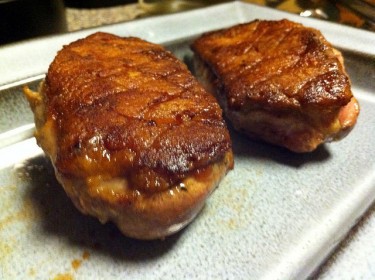
It’s easy to mistake duck for some sort of luxe specialty meat. The Chicken Industrial Complex holds near total dominion over the poultry aisle in our supermarkets, and we usually first encounter this most comical of waterfowl in a French or Chinese restaurant, if ever. In many cultures, duck is a staple, and visitors must be puzzled by its rarity here, like with lamb — or “futbol.”
But you really don’t need a lot of money, time or even skill to prepare duck at home. If you keep it simple with sides, this dinner can be made in under a half-hour. And duck is delicious too, especially the crispy skin, which is texturally a lot like bacon. It can be enjoyed with a fruit-and-booze glaze, or with just salt and pepper, and both are manageable for weeknight cooking. It’s not difficult; if it were I promise you that I would have no idea how to do it.
Admittedly, we’re talking about a bit of a culinary oddball: red meat poultry, which can be served rare without giving anyone a dreadful disease. In fact, this is a bird which should be served rare. Like steak, overcooked duck sucks, and if you prepare a duck breast properly the meat should remind you somewhat of a steak, with pink to blood-red meat, depending on your preference.
Finding a duck breast can be a challenge in a standard grocery store, so hopefully, wherever you live, you’ve got a decent butcher shop nearby. In New York, we’re lucky enough to be at the epicenter of the American duck industry: Long Island, the home of the White Pekin, known commercially known as “Long Island Duck.” According to Alton Brown, the breed was a Chinese import that “ate greedily, bred lustily, and grew very fast” when they were introduced to Long Island farms. It became a wonderful bird: handsome, mild, busty and charismatic: the Dolly Parton of waterfowl. Just look at this thing. It should be singing in a Disney cartoon! So the White Pekin came to dominate the American duck market, such as it is, and Long Island became the Napa Valley of duck. (Did you realize that the Napa Valley of anything was in Suffolk County? I thought their principal exports were hideous cocktails and embarrassment. I kid, Long Island. How you doing, say hello to your mother.)
The other variety of duck breast you’re likely to find is Magret, probably from one of a few farms in the Hudson Valley. It’s good, but be warned: if you haven’t liked duck in the past, you are especially not going to like this duck. While milder in flavor than the wild specimens that you’ve probably had if you know any duck hunters, Magret has a much gamier flavor than the agreeable Pekin. It’s also freakishly large, because it comes from the unfortunate ducks bred to create foie gras, so eating it may cause self-loathing in the sensitive. You’ll probably find Long Island breasts as two lobes connected by a single piece of skin, a portion which weighs around one pound and which will comfortably feed two people. The Magret breast is often closer to four pounds, and sold by the single lobe. For either type of duck, expect to pay between $9 and $12 per pound.
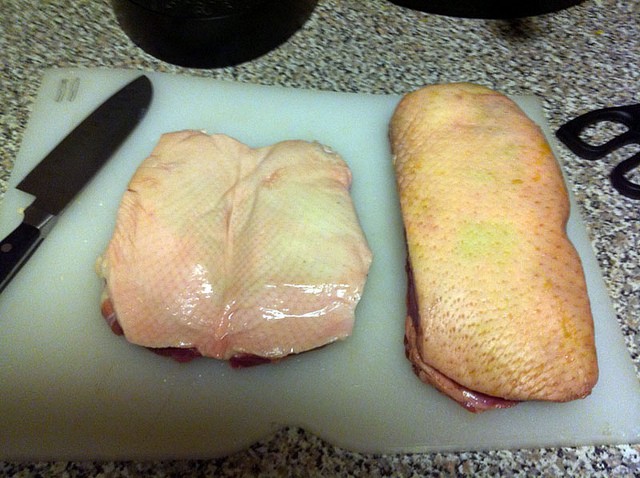
Whole ducks can also be found at a good grocery or butcher shop, fresh or frozen at around five bucks a pound. They are good simply roasted in the oven, much like a chicken. They can also be given the royal treatment: Peking Duck. To experience that in its full majesty, go to the Beijing Da Dong Peking Duck Restaurant, which, yeah, is in China. The duck is carved table-side, and served with the traditional crepes, hoisin sauce, and various other condiments like daikon and green onion. You roll the whole thing up and put it into your gaping maw, and then repeat. The skin is served separately, beside a dish of raw sugar, so that when you dunk the hot skin into the sugar bowl with your chopsticks it turns to caramel, right there at the table. It’s insane. They will also present you with the duck’s head, bisected, so that at the height of your duck-crazed fugue state, you can suck Daffy’s adorable little brains straight from his skull.
But this isn’t Beijing, and you’re not a Peking Duck chef. I’ll leave it to you, but my advice is this: don’t try to recreate Peking duck at home. Sure, there are recipes on the Internet, but look, you’re going to have to spend a whole afternoon just drying the damn thing out. The duck’s corpse will be hanging piteously on a meat hook in your closet, just waiting for some unsuspecting person to find it and start screaming. Do you even own a meat hook? I never trust a person who does. And in addition to all that, my feeling is that the result will disappoint you. Maybe not, though. Maybe you like a project. Maybe you make your own sushi, too. In that case, have fun. For everyone else, either get on a plane for 18 hours, or go to Chinatown, where several places offer an almost good-enough facsimile of the Da Dong experience.
But for weeknights, there is always the pan-roasted duck breast. So let’s get started.
A quick note of caution: I’ve found that many duck breast recipes are unclear about the type of duck that they require. In this recipe from Mark Bittman, he’s clearly talking about a giant Magret, because the times and temperatures he uses would absolutely annihilate a humble White Pekin breast. But here, Gordon Ramsay is working with a White Pekin breast, or some British equivalent, again without mentioning it. This is a weird phenomenon; you wouldn’t cook a rib-eye the same way you would a shell steak. So to be clear: the directions below are for a White Pekin breast.
Prep is no big deal. Look at the breast: there is the lean side, and then there’s the skin side, which is easy to pick out because it’s resting on a thick layer of creamy duck fat. Your first thought is going to be: whoa, that is a lot of fat. Two things to keep in mind: Granted I’m no authority on these topics, but I’ve read that duck fat is better health-wise than other fats. Also, and more importantly, we are going to introduce this breast to heat gradually, so that the majority of the fat will render right out of the duck. When you’re done you should strain and save this fat in the refrigerator, because it is delicious, and it will make the best fried potatoes you’ve ever had.
Pre-heat your oven to 200 degrees. Season both sides of the breast with kosher salt and black pepper to taste, and then put it on a cutting board, skin-side up. With a sharp knife and a careful hand, gently score the skin in a crisscross pattern, which will not only make the duck look very preppy in its argyle sweater, but will also create channels through the fat to help it flow away as it melts off. Be reasonably careful not to pierce the tender flesh beneath. Now, slice the fat and skin that separates the two lobes of the breast, so that you have two individual and mostly equal-sized pieces. You’re done with prep.
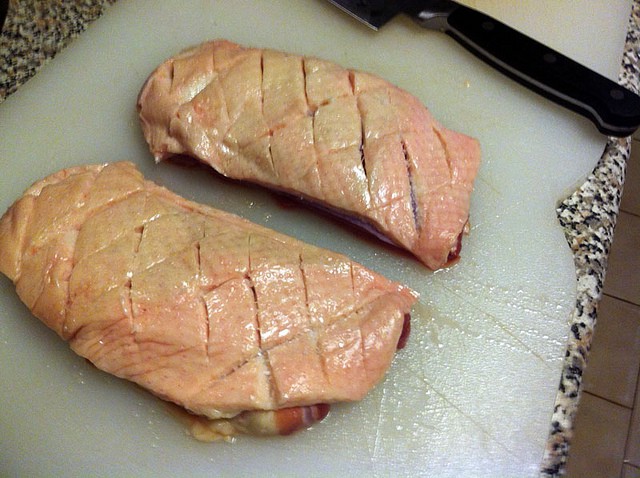
Put both pieces of the breast, skin-side down, on the stove in a dry, room-temperature skillet, and then gradually turn the heat up to medium-high. That’s correct, no oil. As the heat rises and the fat begins to render and fill the pan, you will understand why. Once you hear the sizzling, you’re in business, so set your timer for five minutes. Let the meat sit undisturbed until the timer goes off, and then pick up an edge of one piece with your tongs and sneak a glance at the skin. It should be golden brown, crisp, and bacon-ish. Let it sit there for a few more minutes if you aren’t satisfied with the color, or with the amount of fat rendered.
Also, your skillet should be filling with molten duck fat. This is the risky part. You don’t want the bird to poach in that stuff, but you also don’t want to throw it away. Get a big bowl, and then upend your pan, holding the breast tightly against the surface with a spatula or tongs, so that you can drain the fat into the bowl. Do this a few times throughout the process. Please be careful, because hot duck fat could burn your face off. If what I’m saying makes you nervous, and who could blame you, just tip the pan and continuously scoop away the goo with a spoon.
So, the duck’s skin is now crisp. Flip it over and sear the other side for two minutes or so. Then flip it again to the skin-side before putting your pan into the 200° oven. Did I mention that you should be using a pan which does not have a plastic handle? I probably should have. Roast from five to eight minutes, depending on your desired done-ness, and then remove the pan and move the breast to a waiting plate.
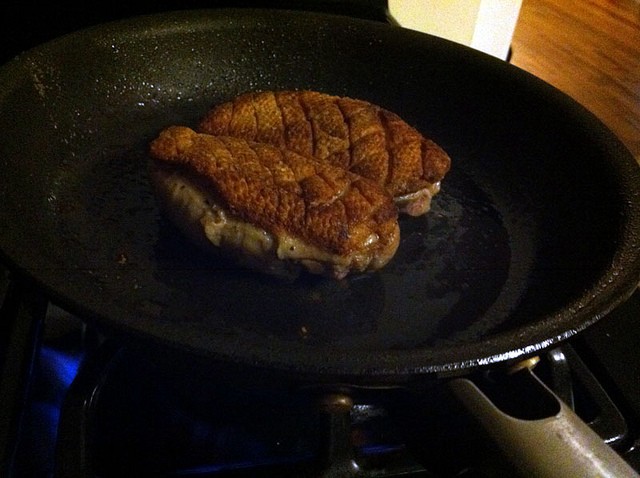
Now pretend that you just cooked a steak. Poke the lean side with your finger to see how well you did. Is it springy, but firm? That’s medium rare. If it’s really soft, it isn’t done, so put it back in the oven for a few. Also, as with a steak, if you cut the meat immediately, the juices are going to run out, and the meat will become useless. Your duck needs to rest, so loosely tent the plate with foil (you want to keep the meat warm, but you don’t want it to steam) and let it relax for as close to ten minutes as your guests will allow. Slice thin pieces for better presentation value, or thick ones to keep the meat warmer on the plate.
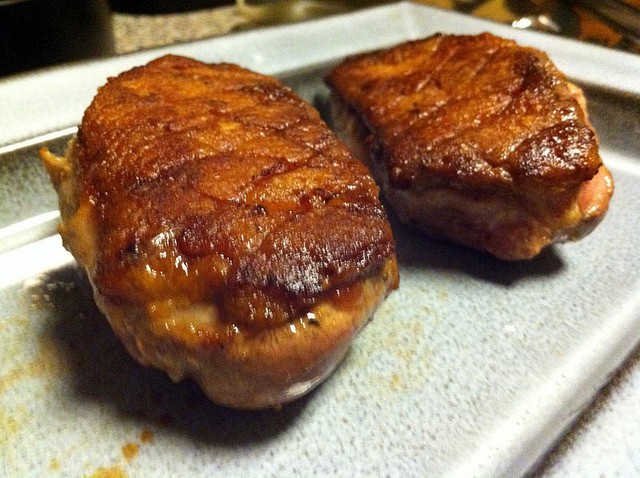
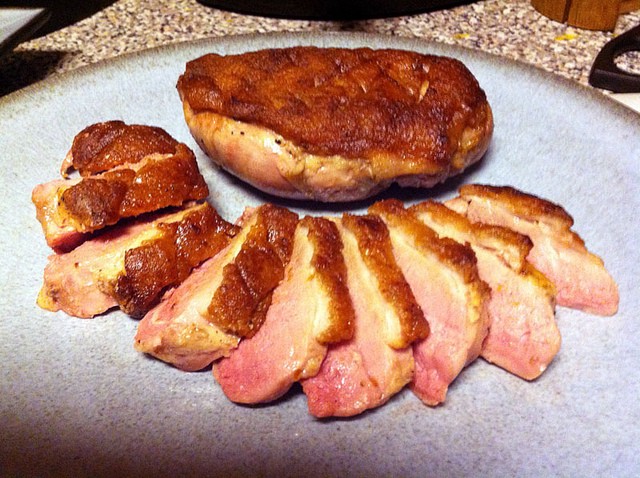
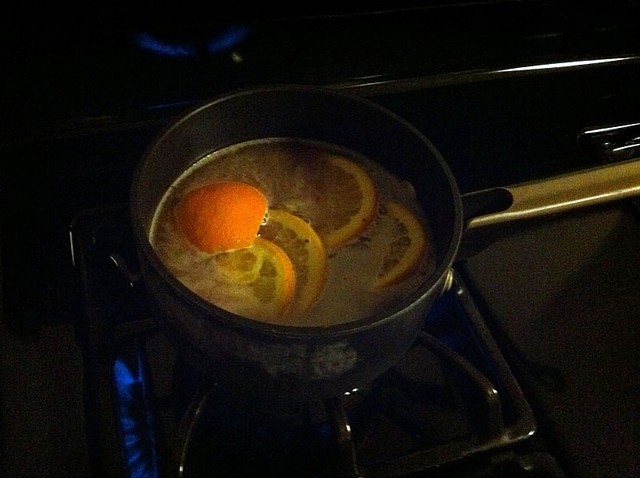
That’s pretty much it. Easy, right? Serve it with a salad or something else light — rice or maybe couscous — because this is going to be a fairly rich meal. You should also consider whipping up a simple pan-sauce while the duck rests. L’orange sauce, hoary old classic that it is, is excellent and no particular trouble to prepare. Citrus, cherries or berries all work well, as does a balsamic reduction, or a Soy and Mirin glaze. Or check out what these Australian fellows do with pears, wine and balsamic. There are few wrong answers here, so get creative and enjoy.
Related: How To Make Weeknight Pasta Sauce
Brian Pritchett is a writer and web producer in Brooklyn.
